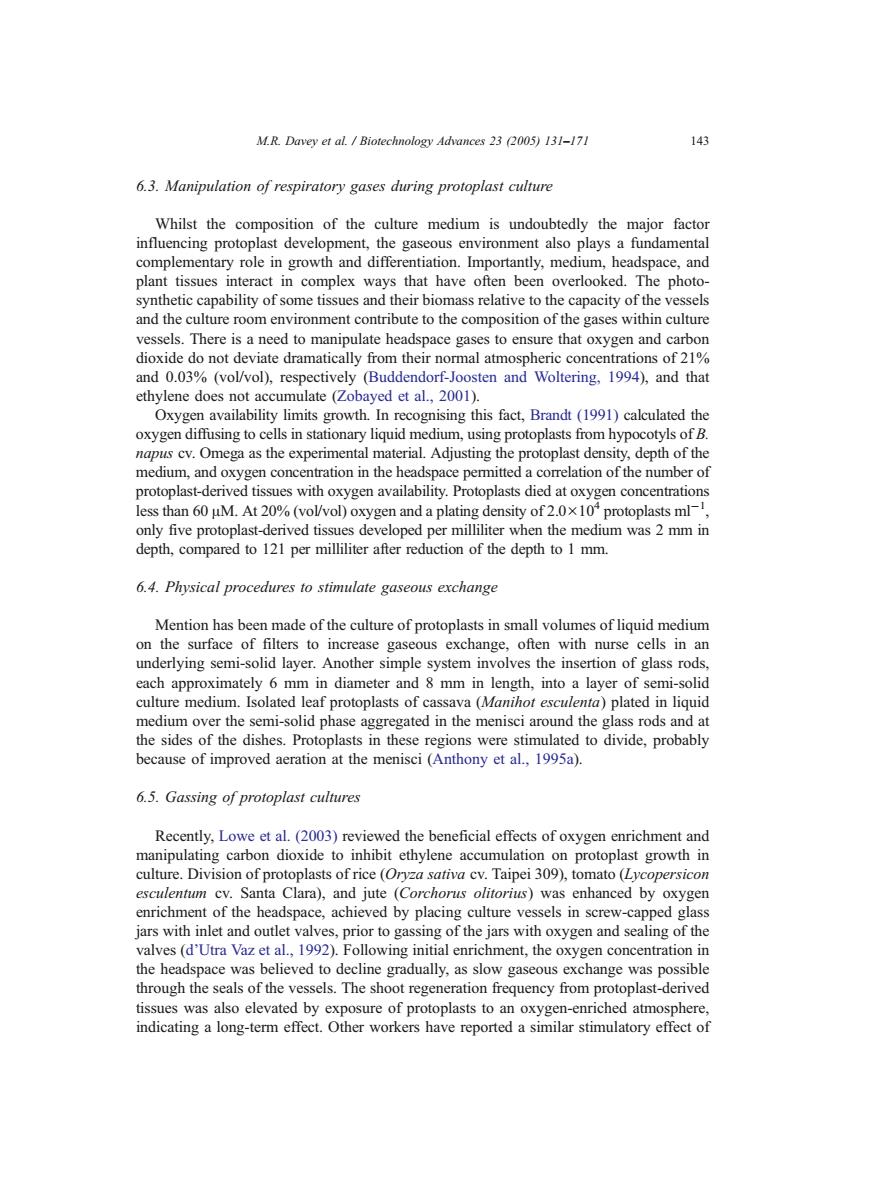正在加载图片...

M.R.Davey et al.Biotechnology Advances 23 (2005)131-171 143 6.3.Manipulation of respiratory gases during protoplast culture Whilst the composition of the culture medium is undoubtedly the major factor influencing protoplast development,the gaseous environment also plays a fundamental complementary role in growth and differentiation.Importantly,medium,headspace,and plant tissues interact in complex ways that have often been overlooked.The photo- synthetic capability of some tissues and their biomass relative to the capacity of the vessels and the culture room environment contribute to the composition of the gases within culture vessels.There is a need to manipulate headspace gases to ensure that oxygen and carbon dioxide do not deviate dramatically from their normal atmospheric concentrations of 21% and 0.03%(vol/vol),respectively (Buddendorf-Joosten and Woltering,1994),and that ethylene does not accumulate (Zobayed et al.,2001). Oxygen availability limits growth.In recognising this fact,Brandt(1991)calculated the oxygen diffusing to cells in stationary liquid medium,using protoplasts from hypocotyls of B. napus cv.Omega as the experimental material.Adjusting the protoplast density,depth of the medium,and oxygen concentration in the headspace permitted a correlation of the number of protoplast-derived tissues with oxygen availability.Protoplasts died at oxygen concentrations less than 60 uM.At 20%(vol/vol)oxygen and a plating density of 2.0x10protoplasts ml-, only five protoplast-derived tissues developed per milliliter when the medium was 2 mm in depth,compared to 121 per milliliter after reduction of the depth to 1 mm. 6.4.Physical procedures to stimulate gaseous exchange Mention has been made of the culture of protoplasts in small volumes of liquid medium on the surface of filters to increase gaseous exchange,often with nurse cells in an underlying semi-solid layer.Another simple system involves the insertion of glass rods, each approximately 6 mm in diameter and 8 mm in length,into a layer of semi-solid culture medium.Isolated leaf protoplasts of cassava (Manihot esculenta)plated in liquid medium over the semi-solid phase aggregated in the menisci around the glass rods and at the sides of the dishes.Protoplasts in these regions were stimulated to divide,probably because of improved aeration at the menisci(Anthony et al.,1995a). 6.5.Gassing of protoplast cultures Recently,Lowe et al.(2003)reviewed the beneficial effects of oxygen enrichment and manipulating carbon dioxide to inhibit ethylene accumulation on protoplast growth in culture.Division of protoplasts of rice (Oryza sativa cv.Taipei 309),tomato (Lycopersicon esculentum cv.Santa Clara),and jute (Corchorus olitorius)was enhanced by oxygen enrichment of the headspace,achieved by placing culture vessels in screw-capped glass jars with inlet and outlet valves,prior to gassing of the jars with oxygen and sealing of the valves(d'Utra Vaz et al.,1992).Following initial enrichment,the oxygen concentration in the headspace was believed to decline gradually,as slow gaseous exchange was possible through the seals of the vessels.The shoot regeneration frequency from protoplast-derived tissues was also elevated by exposure of protoplasts to an oxygen-enriched atmosphere, indicating a long-term effect.Other workers have reported a similar stimulatory effect of6.3. Manipulation of respiratory gases during protoplast culture Whilst the composition of the culture medium is undoubtedly the major factor influencing protoplast development, the gaseous environment also plays a fundamental complementary role in growth and differentiation. Importantly, medium, headspace, and plant tissues interact in complex ways that have often been overlooked. The photosynthetic capability of some tissues and their biomass relative to the capacity of the vessels and the culture room environment contribute to the composition of the gases within culture vessels. There is a need to manipulate headspace gases to ensure that oxygen and carbon dioxide do not deviate dramatically from their normal atmospheric concentrations of 21% and 0.03% (vol/vol), respectively (Buddendorf-Joosten and Woltering, 1994), and that ethylene does not accumulate (Zobayed et al., 2001). Oxygen availability limits growth. In recognising this fact, Brandt (1991) calculated the oxygen diffusing to cells in stationary liquid medium, using protoplasts from hypocotyls of B. napus cv. Omega as the experimental material. Adjusting the protoplast density, depth of the medium, and oxygen concentration in the headspace permitted a correlation of the number of protoplast-derived tissues with oxygen availability. Protoplasts died at oxygen concentrations less than 60 AM. At 20% (vol/vol) oxygen and a plating density of 2.0104 protoplasts ml1 , only five protoplast-derived tissues developed per milliliter when the medium was 2 mm in depth, compared to 121 per milliliter after reduction of the depth to 1 mm. 6.4. Physical procedures to stimulate gaseous exchange Mention has been made of the culture of protoplasts in small volumes of liquid medium on the surface of filters to increase gaseous exchange, often with nurse cells in an underlying semi-solid layer. Another simple system involves the insertion of glass rods, each approximately 6 mm in diameter and 8 mm in length, into a layer of semi-solid culture medium. Isolated leaf protoplasts of cassava (Manihot esculenta) plated in liquid medium over the semi-solid phase aggregated in the menisci around the glass rods and at the sides of the dishes. Protoplasts in these regions were stimulated to divide, probably because of improved aeration at the menisci (Anthony et al., 1995a). 6.5. Gassing of protoplast cultures Recently, Lowe et al. (2003) reviewed the beneficial effects of oxygen enrichment and manipulating carbon dioxide to inhibit ethylene accumulation on protoplast growth in culture. Division of protoplasts of rice (Oryza sativa cv. Taipei 309), tomato (Lycopersicon esculentum cv. Santa Clara), and jute (Corchorus olitorius) was enhanced by oxygen enrichment of the headspace, achieved by placing culture vessels in screw-capped glass jars with inlet and outlet valves, prior to gassing of the jars with oxygen and sealing of the valves (d’Utra Vaz et al., 1992). Following initial enrichment, the oxygen concentration in the headspace was believed to decline gradually, as slow gaseous exchange was possible through the seals of the vessels. The shoot regeneration frequency from protoplast-derived tissues was also elevated by exposure of protoplasts to an oxygen-enriched atmosphere, indicating a long-term effect. Other workers have reported a similar stimulatory effect of M.R. Davey et al. / Biotechnology Advances 23 (2005) 131–171 143�